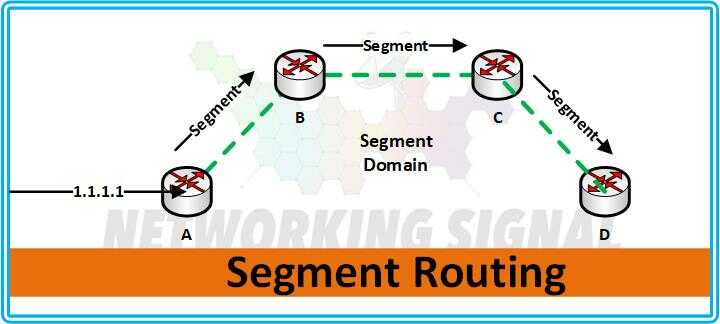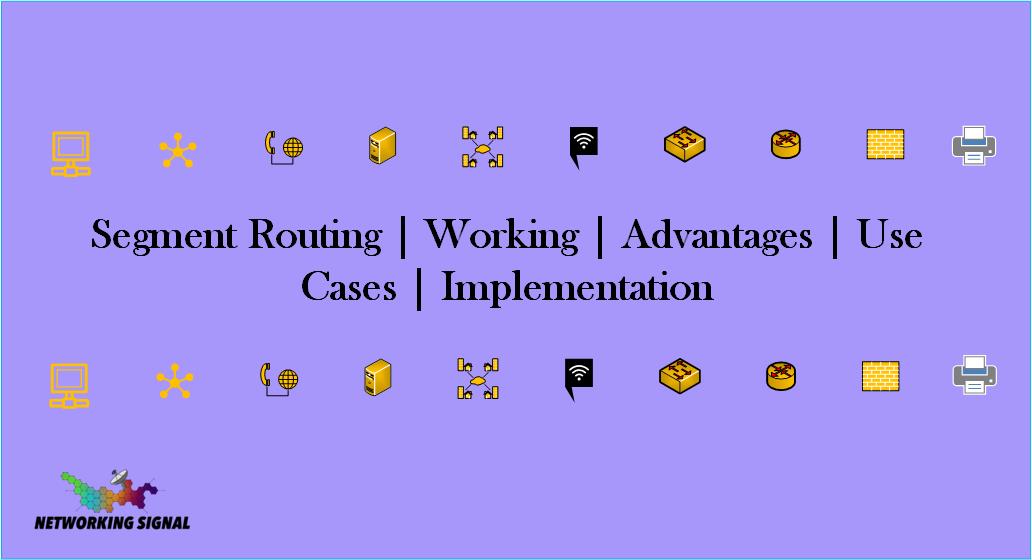What is Segment Routing?
Segment Routing is an IP-based network routing protocol that uses source routing. It enables packets to be forwarded along a set of predefined paths, known as “segments”, which are based on the instructions provided by the source node.
This makes it possible for routers to quickly locate and forward packets along their intended paths more efficiently than traditional routing protocols. Additionally, Segment Routing is scalable and fault-tolerant, which makes it ideal for use in large networks with multiple hops between nodes.
How Does Segment Routing Work?

The working of Segment Routing is based on the concept of “segments”. Each segment consists of a set of instructions that define how packets should be forwarded along their intended paths.
A source node can specify multiple segments in its routing information and each segment will contain one or more actions, such as forwarding to another node, dropping the packet, etc.
When the packet arrives at the router, it looks up its routing table to locate the corresponding segment. It then executes the instructions associated with that segment and forwards the packet accordingly. This makes it possible for routers to quickly forward packets along their intended paths without having to consult a central routing database each time.
Additionally, since segments can be dynamically changed, Segment Routing allows for dynamic and flexible routing of packets.
Example:
Consider a network of nodes A, B, C & D. Node A wants to send a packet to node D, and it knows that the best route for this is via node B and then node C. With segment routing, Node A can specify two segments in its routing information:
- The first segment instructs all routers to forward the packet to node B.
- The second segment instructs all routers to forward the packet to node C, which in turn forwards it to D.
In this way, Node A can specify two segments, and all routers along the path will execute the instructions associated with each segment and forward the packet accordingly. This makes routing more efficient and dynamic, as the source node can easily change or add segments to adjust the path of the packet.
What are the Advantages of Segment Routing?
Here are some of the advantages of Segment Routing:
- Improved scalability: Because segments can be dynamically changed, Segment Routing makes it easier to scale networks with more complex routing requirements.
- Improved resilience and fault tolerance: By using multiple segments, routers are able to quickly identify alternative paths in case of link or node failure.
- Reduced network overhead: By eliminating the need for routers to consult a central routing database each time, Segment Routing reduces the amount of network traffic and processing required for packet forwarding.
- Improved performance: Networks using Segment Routing can experience increased performance due to reduced latency and faster route convergence.
What are the Disadvantages of Segment Routing?
Here are some of the disadvantages of Segment Routing:
- Complex configuration: Configuring segments and routes can be complicated, requiring advanced knowledge of routing protocols.
- Security risks: If misconfigured, segment routing could present a security risk by allowing malicious users to gain access to networks or services that should not be accessible.
- Limited support: Segment routing is still a relatively new concept and not all devices or services offer full support for it.
What are the Use Cases of Segment Routing?
Segment Routing can be used in many different use cases, such as:
- Datacenter interconnectivity: Segment Routing allows for efficient and dynamic routing between data centers.
- Intelligent traffic engineering: Segments can be used to better manage traffic flows in order to improve performance or reduce congestion.
- Optimized streaming: Segments can be used to improve video and audio streaming performance by dynamically routing traffic around restrictions or congestion.
- Network virtualization: Segments can be used to set up virtual networks for different applications, users, or customers.
- Traffic engineering: By using segments, network operators are able to more effectively manage their networks in order to improve performance and provide a better quality of service.
Comparison Segment Routing with other Routing Protocols
Segment Routing is different from other routing protocols because it organizes the network into segments, rather than paths. This enables routers to quickly identify alternative routes in case of failure and allows for more dynamic and flexible routing.
Unlike traditional routing protocols, such as Open Shortest Path First (OSPF) or Border Gateway Protocol (BGP), Segment Routing does not require routers to consult a central routing database each time. This reduces the amount of network overhead and improves performance.
Segment Routing vs MPLS
MPLS and Segment Routing are both used for traffic engineering, but they work differently. MPLS performs path selection by evaluating a central repository of routes, while Segment Routing defines segments that routers can use to dynamically create paths.
Segment Routing is more efficient than MPLS because it does not require routers to repeatedly consult a central routing database. Additionally, Segment Routing is more flexible and can be used to easily adjust routes on-the-fly.
Segment Routing vs BGP
BGP and Segment Routing are both used to route packets between networks, but they work differently. BGP relies on the exchange of routing information between directly connected routers, while Segment Routing defines segments that routers can use to dynamically create paths.
Segment Routing is more efficient than BGP because it does not require routers to exchange routing information each time a new path needs to be created.
Implementation of Segment Routing
Segment Routing is implemented using two components: the Segment Routing Global Block (SRGB) and the Segment Identifier (SID). The SRGB defines a range of SIDs that can be used by nodes in the network, while the SID is used to identify an individual segment within this range.
Here are the steps for implementing Segment Routing:
- Create a topology of the network and identify the nodes in it.
- Define an SRGB to be used by all the nodes in the network.
- Assign SIDs to each segment and configure the routers with these SIDs.
- Configure routers to use Segment Routing for routing and traffic engineering.
- Monitor the network for any changes in the topology or traffic patterns and adjust SIDs accordingly.
Which Type of Topology is Used in Segment Routing?
Segment Routing can be used on any type of topology, such as bus, ring, star, or mesh. However, the most common and effective way to implement Segment Routing is using a mesh topology. A mesh topology provides better redundancy compared to other types of topologies, which makes it more suitable for segment routing.
Additionally, a mesh topology can provide more efficient paths for traffic engineering and routing, which makes Segment Routing more effective.

